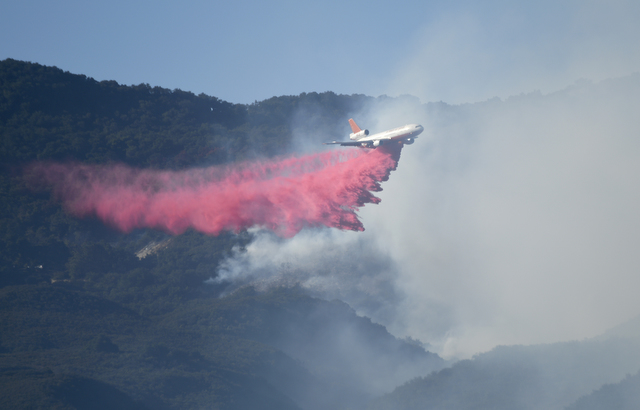Air Tankers, Copters Bombard Scherpa Blaze
Santa Maria Crews Pump Nearly 220,000 Gallons of Retardant into Red Skies

Today’s air assault on the Scherpa Fire commenced at 8:30 a.m., with one DC-10, four four-engine jet air tankers, and one CAL FIRE S-2 air tanker, according to Jim Kunkle, who runs the Central Coast Jet Center out of Santa Maria’s airport, where all the tankers are loaded and launched with fuel and chemical fire retardant.
Kunkle said there at least 15 helicopters parked at the Santa Ynez Airport as well. “Pretty much everything they need, they’ve gotten,” Kunkle said. On Wednesday — the first day of the blaze — there were two DC-10s —large, reassuring, and photogenic but also unwieldly in steep and narrow box canyons. One was on its way from Sacramento to Roswell, New Mexico and dropped only one load.
DC-10s can carry large quantities of retardant and are effective at laying down thick stripes of unmistakably red retardant along ridgelines that often define the outer perimeter of “the box” into which firefighters are seeking to corral the blaze. The other air tankers carry smaller loads but are much more nimble in tight spaces. Kunkle said he didn’t have the latest numbers of flights that have taken off from the county’s air tanker base in Santa Maria but noted his crews have pumped nearly 220,000 gallons of retardant since the fire started two days ago.
Given the proximity of the fire to the tanker base, Kunkle said the turn-around times have been exceedingly short. He estimated it took most of the four-engine propeller jets about 20 minutes to load, take off, drop, return, touch down, and get ready to reload. With such fast turn-around times, suggested Kunkle, there could be air-traffic control issues if many more firefighting aircrafts were deployed.
Leading the bombing runs is what’s known as the lead plane, which flies in as low as is safe, showing pilots carrying loads exactly where to discharge. Guiding it all from above are air attack planes that function as air traffic controllers. At any given time, one of each is in action. Kunkle said most of the planes are dropping from about 150 feet. Pilots, he said, are limited to no more than eight hours a day of actual firefighting flight time. That does not include the time spent to refuel and load.


